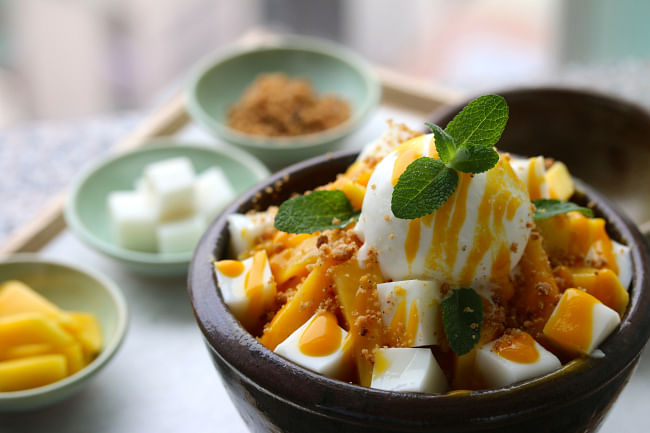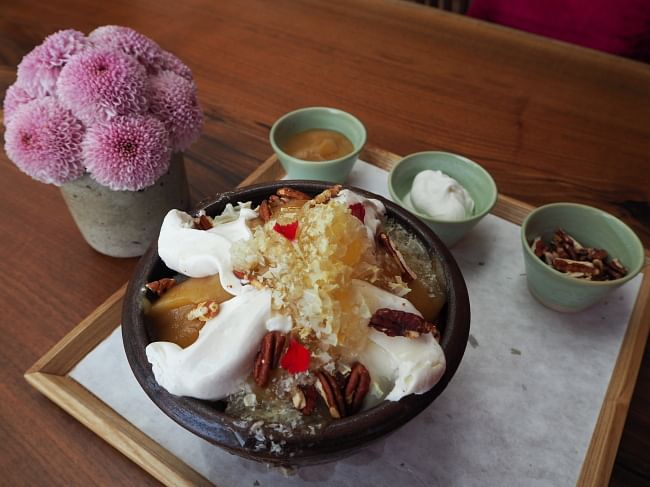(THE KOREA HERALD/ASIA NEWS NETWORK) - If Italy has gelato and France has sorbet, South Korea has bingsu.
It is a national dessert made of shaved ice, milk and condensed milk and often topped with sweetened red beans or fruit. It is a dish beloved across generations, chilling tastebuds and slaking thirst in the thick of summer.
After a meal, South Koreans like to go to a bingsu store to dive into a bowl of shaved ice, usually with friends or family. While the original "patbingsu" is made of ice, milk and red beans, more varieties have been added over the years, leading to those bursting with green tea ice cream, frozen fruit, rice cake, yogurt and coffee. There is even alcoholic bingsu, concocted using Korea's traditional rice wine, makgeolli.
Park Hyatt Seoul's teahouse restaurant The Lounge has four types of bingsu: makgeolli, honey, mango and red bean. The desserts are prepared by sous chef Justin Kim, who has been striving to find a sensible meeting point between the country's classic cuisines and the world's cosmopolitan cravings.
"The makgeolli bingsu is our signature dessert, prepared with the finest ingredients of makgeolli and various berries and toppings," he says. "Many foreigners find the milky, chalky taste of the rice wine unfamiliar at the start, so we have eliminated the strong alcoholic taste by vaporising the alcohol and mixing it with berries and toppings."
The bingsu uses makgeolli - a rice-based, opaque and coarsely fermented liquor that is a member of the "takju" family - and ice flakes, berries, oranges and grapefruit, which are then topped with pistachio paste and mint. The flavour has a tinge of alcohol, but one that is not strong enough to inebriate.

"It's our unique dish and we are the first to develop it," he says, explaining the process of ablating the alcohol through boiling and freezing. It is then used as the shaved ice.
Many foreigners, particularly the Japanese, who have tried it for the first time "absolutely fall in love with it", said the chef.
Korean desserts such as cinnamon punch "sujeonggwa," sweet rice drink "sikhye" and rice cake "tteok" have become more diverse and sophisticated over the years and so has bingsu, Kim noted. He pointed to advanced cooking techniques and nuanced cookeries that have gentrified the tastes of consumers.
"Similar to Taiwan's mango bingsu, we want to popularise our bingsu around the world. When foreigners come to South Korea, I want them to try it as a must-eat dessert," Kim says. "I think promoting it at events such as the summer and winter Olympics and international conferences would be a great idea."
Bingsu was confined to the realm of upper-crust society when it entered Korea's culinary scene in the early 20th century through the Japanese colonialists. As there were not enough refrigerators available, bingsu was considered a rare delicacy.
With the franchisation of bingsu since the 1980s, the dessert has entered the mainstream. Although different varieties exist in Japan, Taiwan and elsewhere, South Korea's bingsu is unique, with sundry toppings such as rice cakes and red beans, a recipe similar to bibimbap, a Korean dish made by mixing rice, vegetables, meat and condiments.

The Taegeukdang bakery in central Seoul has been selling old-style bingsu for more than a decade. Founded in 1946, just after Korea gained independence from Japan, the confectionery store has been the preserve of old memories for many of its customers, some of whom are in their 80s. Since reopening in late 2015, following an extensive renovation, the patisserie has a new interior dripping with art deco charm and elegance.
"We pride ourselves in making bingsu the same way it was made in the old days," the store's brand manager Shin Hye-myung said, referring to the recipe using crudely shaven ice, condensed milk and steamed sweet red beans.
"That makes our bingsu unique. People of all ages like it because it harkens back to the old taste they are used to. With a refreshing and simple taste, you don't get fed up."
Taegeukdang also sells monaca bingsu, which uses red beans, rice cakes and the milk ice cream that the shop has been famous for. Its signature monaca ice cream has kept the same flavour for more than 50 years as it has been prepared by the same baker since 1966.
During the daytime, people in their 70s and 80s haunt the place, the third-generation owner said, adding that more and more foreigners also visit through word of mouth.

